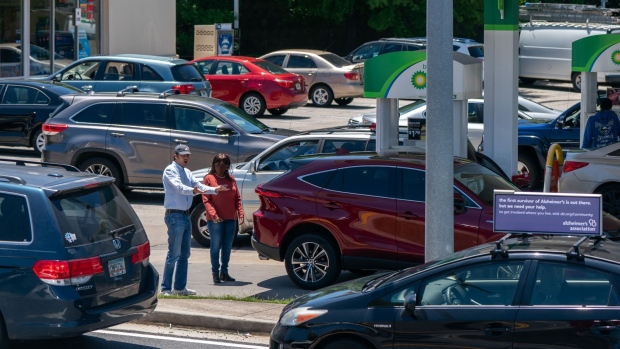May 15, 2021
Uber Drivers Stranded as Gas Shortage Throttles Gig Economy
, Bloomberg News

(Bloomberg) -- Uber Technologies Inc. and Lyft Inc. have been desperate for weeks to recruit drivers to meet a sharp rise in demand for rides. They were just dealt a major setback by the disruption of the Colonial Pipeline, which sparked a wave of panic-buying that has only exacerbated shortages and pushed some drivers off the road just when they’re needed most. It’s also forcing ride-hailing and food-delivery drivers to make tough decisions about when a job is worth hours spent in line to fill up and gas prices that have hit the highest in more than six years.Sarah Voss, 22, is a driver for food delivery giant DoorDash in Greenville, South Carolina. In that area, almost 80% of gas stations reported having limited or no fuel, according to Gas Buddy, an app that helps users find and save money on gas. “I’ve had to be more selective in what kind of orders I take and how often I work now,” Voss said, adding she’s already skipped an entire day of work which set her back as much as $70 in potential earnings. “If I don’t have gas, I can’t work.”
The temporary shutdown of the largest gasoline conduit in the U.S. last week after a hack has uniquely affected gig companies, as the increasing demand for ride-share collides with the need to staff food-delivery services. When ridership fell sharply during the pandemic, many drivers for Uber and Lyft either sought work elsewhere or applied for government stimulus programs. Now that more people are heading back to work and out and about in town, that’s left the ride-hailing companies scrambling, while DoorDash has only continued to see an insatiable appetite for food delivery, despite the reopening of restaurants. The smaller pool of total drivers has led to longer wait times and higher fares for customers.DoorDash Inc. is offering incentives to keep its workers on the road and help merchants understand the resources at their disposal. The company has been granting Peak Pay bonuses to help compensate drivers who are choosing to work in a stressful time. It’s also offering additional discounts on car maintenance as well as 2% cash back at any gas station to members who have a DashDirect card. "We will continue to monitor the situation and pursue necessary action to stabilize stressors,” a spokesperson said. Colonial Pipeline Co. began restoring service on Wednesday afternoon but warned that it may be several days before operations return to normal. Panic-buying hasn’t waned and has even spread to areas ostensibly well-supplied with fuel in Texas. On Friday, Washington became the state worst-hit by the fuel shortage with 81% of its gas stations depleted.Drivers from Florida to North Carolina said demand for rides has surged in recent days as people opt to conserve their own supply by taking a hired car. “It’s been nonstop,” said Marty Doucette, a Florida-based Uber driver who drove to four different gas stations before he was able to refuel his pickup truck. “The only option I had to fill my tank was premium, which cost me an additional $30 compared to my normal fill up. If the panic-buying continues it will put me out of work.”
Despite the uptick in customers, he went home early. Most of them weren’t worth taking due to the distance to pick up a passenger, given the scarcity of gas and the hit of pricier fuel on take-home profits, he said.
The ride-hailing companies have already been doling out cash bonuses for driving or referring new drivers, and Uber earmarked an additional $250 million in April for incentives to entice drivers back on the road. Uber declined to comment on incentives due to the gas shortage.
DoorDash reported this week that sales tripled in the first quarter, bucking expectations that people would start to wean themselves off of pandemic-era dinner delivery. The San-Francisco-based company said it saw a “supply blip” in March, but that it was “solved.” DoorDash expects to acquire more drivers, in the foreseeable future, executives said on a call with analysts on Thursday.
“Driver shortages are definitely impacting all gig companies right now,” said Bloomberg Intelligence analyst Mandeep Singh. “There’s a multitude of factors at play, including the gas shortage.”
Voss, the DoorDash driver in Greenville, said she noticed more of the incentives than usual, ranging from $1 to $4.50, since the shortage began. Though it’s enticing for the undergraduate student, who depends on the food-delivery service for the majority of her income, she can’t take full advantage of the offer. “My boyfriend has a full-time job and we share one car, so I have to make sure that we’ll have enough gas for him to be able to get to and from work,” she said.But companies are making the jobs irresistible to some drivers. In Virginia Beach, DoorDash driver Jean Paul, said on Wednesday he averaged more than $30 an hour for four hours. It was his “best day ever” in the three years he’s been on the delivery platform, even factoring increased fuel costs for his small Kia. He was initially worried about not being able to work the weekend -- the most profitable period for orders -- but after searching across gas stations early Friday, he got lucky. “I’d be willing to wait for hours if it meant I can get gas.”
©2021 Bloomberg L.P.





